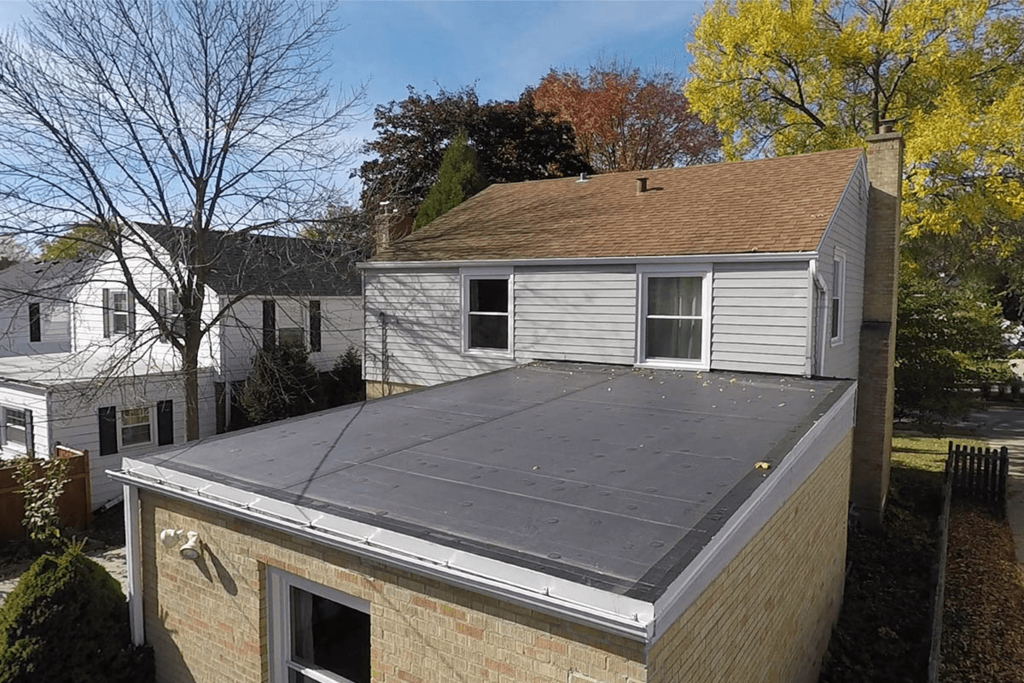Explore this post with:
Your flat roof, aged 18 to 20 years, might still have several years of service ahead before requiring replacement. However, this longevity is not guaranteed considering Toronto’s severe climate and maintenance demands. While modern flat roof membranes are durable, they are not indestructible.
If your industrial or commercial flat roof needs replacement, you may wonder what you should do next. Strategic planning can keep you on track with your schedule and budget, minimizing unexpected alterations and extra expenses.
Ensure the Roofers Can Access Your Roof
The roofers require roof access to complete the task. While a professional roofer strives for neatness, replacing an old roof is a sizable project that occupies significant space around your home’s perimeter.
Clearing driveways and sidewalks before roofers arrive is crucial to safeguarding outdoor belongings from debris and facilitating efficient work. If feasible, relocate vehicles and belongings from the driveway to ensure the safety of cars, children’s toys, and other items from potential debris or dust. Similarly, if patio furniture, grills, or other items are near the house, consider moving them to the garage or shed, or cover them with a tarp during the work.
Calculate the Cost of Replacing a Flat Roof

When considering a flat roof replacement cost expectations, the initial question for many is the cost involved. Estimating the price involves various factors, so it’s advisable not to expect an immediate figure over the phone from a contractor. Establishing a clear agreement with the roofer and comprehending all details will assist in accurate budgeting and prevent unwelcome surprises. The quotation should encompass:
- The total materials required, such as membrane, insulation, vapor retardant, vents, roof drains, and metal flashings
- Repairing or replacing all roofing components, including roof substrate and parapet blocking as necessary
- Fees for dumping and disposing of old materials
- Time and labor from installation to final inspection
- Equipment rental
Prepare the Exterior
As a homeowner, the last thing you’d want is to get a flat tire from a roofing nail or step on one with bare feet. Skilled roofers thoroughly clean up after installing a roof, using strong magnets and special tools to pick up nails. Before the roof installation, trim your grass short to prevent missing nails in tall grass.
If your roof has a satellite, coordinate with your cable provider to relocate it during installation. Cover flower beds and landscaping with tarps or plastic to shield them from dust and debris. Temporarily remove any hanging plants during the new roof installation.
Home Preparation
While the roofers won’t need to enter your entire home, they will be walking on the roof, creating vibrations that might cause ceiling fixtures to detach or delicate items in the attic to fall and break. It is wise to remove light fixtures and move or cover fragile attic items the day before the team arrives. Additionally, ensure that breakable objects are not positioned against the exterior walls of your house.
You should also consider your children before the roofers start their work. The inevitable noise from a roof replacement can make it difficult for infants and toddlers to nap and may scare younger children with all the activity. If your children are not in school, it might be best for them to stay with friends or family until the project is finished.
Relocate Your Vehicles to the Street
The evening before the crew arrives, relocating any vehicles from your garage or driveway to the street is a good idea. Roofing work usually starts early, with a dumpster being the first delivery for old shingle disposal, followed by another truck carrying the new roofing materials.
While most roofing crews aim to minimize disruptions to your daily routine, parking your cars in the garage might hinder access until the roofing project is done. Additionally, there’s a risk of roofing nails on the driveway that could cause tire damage. Since the process usually spans two to three days, parking on the street is advisable until the work is complete and your property is cleared.
Permits and Regulations
Roofing tasks often demand permits and must comply with local building codes and rules. It’s vital to investigate these prerequisites before commencing the project to prevent expensive delays or legal complications. Here are the steps to follow:
- Get in touch with your local building authority: Contact your local officials to check on the permits and regulations needed for your roofing endeavor.
- Collaborate with your roofing professional: A reliable roofer should be knowledgeable about local codes and permits. They can help you secure the required approvals.
- Allocate funds for permit expenses: Include permit costs in your budget and ensure your contractor incorporates them in their quotes.
Overlooking permits and regulations may lead to penalties and the necessity of redoing parts of the project, so address these matters early on.
Address Waste Disposal and Site Cleanup
Discuss waste removal and cleanup procedures with your roofing contractor before starting the project to keep the work site clean and organized during installation. While many roofing companies manage waste removal and cleanup effectively, verify this beforehand.
Decide on debris disposal methods and confirm if the contractor offers cleanup after the job is finished. A neat work environment boosts safety and minimizes disruptions to your daily schedule.
Research Your Roofing Options

Replacing your roof is a significant investment. Once you’ve decided on a new roof, choose a residential roofing contractor who provides high quality work and materials, along with unmatched expertise.
While engaging with roofers and collecting estimates, it’s wise to understand the size and extent of your project. Understanding your roof’s dimensions and the necessary materials is key. A free roofing calculator calculates the roof’s area, pitch, rafters or trusses, and even the required sheeting boards.
A clear understanding of your roofing project helps prevent underestimating the total replacement cost, which could unexpectedly raise your home remodeling expenses. After establishing a rough budget, collaborating with a skilled residential roofing company can help you stick to it. A proficient roofer spends ample time planning the installation, ensuring a successful roof replacement.
Endnote
Careful planning and informed decision-making in collaboration with a skilled roofing contractor are crucial for a successful flat roof replacement. The choice of a roofing company can significantly impact the quality of the project, ensuring optimal returns on your commercial or industrial property investment from inspection through planning to installation.
In Case You Missed It!
About the Author: Nishant Desai
Nishant Desai has over 8+ years of experience in SEO and blogging. His blogging expertise can organically increase online visibility and traffic for blogs and websites. With his SEO expertise, he has already contributed to iGeeksblog, Firstsportz, and Firstcuriosity. In addition, he can create content strategies, conduct keyword research, publish optimized blogs, and resolve technical issues.




